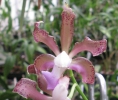|
|
|
|
|
| |
Established Seedlings of
Cattleya bicolor subsp. brasiliensis 'Patricia' × self |
|
| |
|
|
| |
| Number: |
TN8001 |
| Name: |
Cattleya bicolor subsp. brasiliensis 'Patricia' × self
|
| Type: |
self (What's that?) |
|
Seed Donor: |
Mr Gareth Wills
|
|
Click to Enlarge

Pod Parent Flower |
|
|
|
| |
For additional origin/habitat information supplied courtesy of
Charles and Margaret Baker, see further below, near the bottom of this page.
|
Temperatures we attempt to use in the lab & greenhouse:
| For Species: |
|
Spring, Summer, Autumn: days average 81°F, nights 66°F; best fit is Intermediate 83-60°F
(Source:
Baker's Web OSC) |
| For Species: |
|
Winter: days average 74°F, nights 53°F; best fit is Cool 70-52°F
(Source:
Baker's Web OSC) |
| For Genus: |
|
Spring, Summer, Autumn, Winter: days average 83°F, nights 60°F; best fit is Intermediate 83-60°F
(
) |
|
About the name...
| Etymology of |
bicolor |
|
From Latin, two-colored.
(Source:
Mayr & Schmucker 1998) |
| Etymology of |
Cattleya |
|
Named in honor of William Cattley, English horticulturist in the 19th century.
(Source:
Pridgeon 1992) |
| Pronunciation of |
bicolor |
|
BY-col-or
(Source:
Hawkes 1978) |
| Pronunciation of |
Cattleya |
|
KAT-lee-ya
(Sources:
Pridgeon 1992, Hawkes 1978) |
|
If you would like to direct someone to this web page, please copy and paste this URL into your email:
http://troymeyers.com/d?128001
|
ESTABLISHED SEEDLINGS
of these are not currently available, but we have some maturing in the greenhouse and expect to offer them in the future.
There are 3 items with
1 plant per
item that will be considered for sale later.
Click here to see if we have flasks available.
|
|
|
| |
The origin/habitat information below is supplied courtesy of Charles and Margaret Baker
The following information is based on the name of the plant provided by the donor, and assumes that the name is correct. If the plant has been misidentified, then the following information may not be correct.
This text is copyrighted by the Bakers and may not be reproduced without permission.
ORIGIN/HABITAT: Brazil. The habitat includes the coastal mountains between
Rio de Janeiro and São Paulo, and an area between Belo Horizonte and
Formiga. Another population is found further north in the region of
Brasilia.
Plants are now treated as 3 distinct morphologic groups, which are
currently recognized as subspecies bicolor, subspecies minasgeraisensis,
and subspecies brasiliensis.
In addition, Cattleya bicolor has variable flowers, so a name may include
a subspecies designation and then a particular clone name. Each subspecies
originates in widely divergent habitats, so a climate table and habitat
information is included for each subspecies.
More about this information and the Bakers...
|
|
|
| |
|
|
|